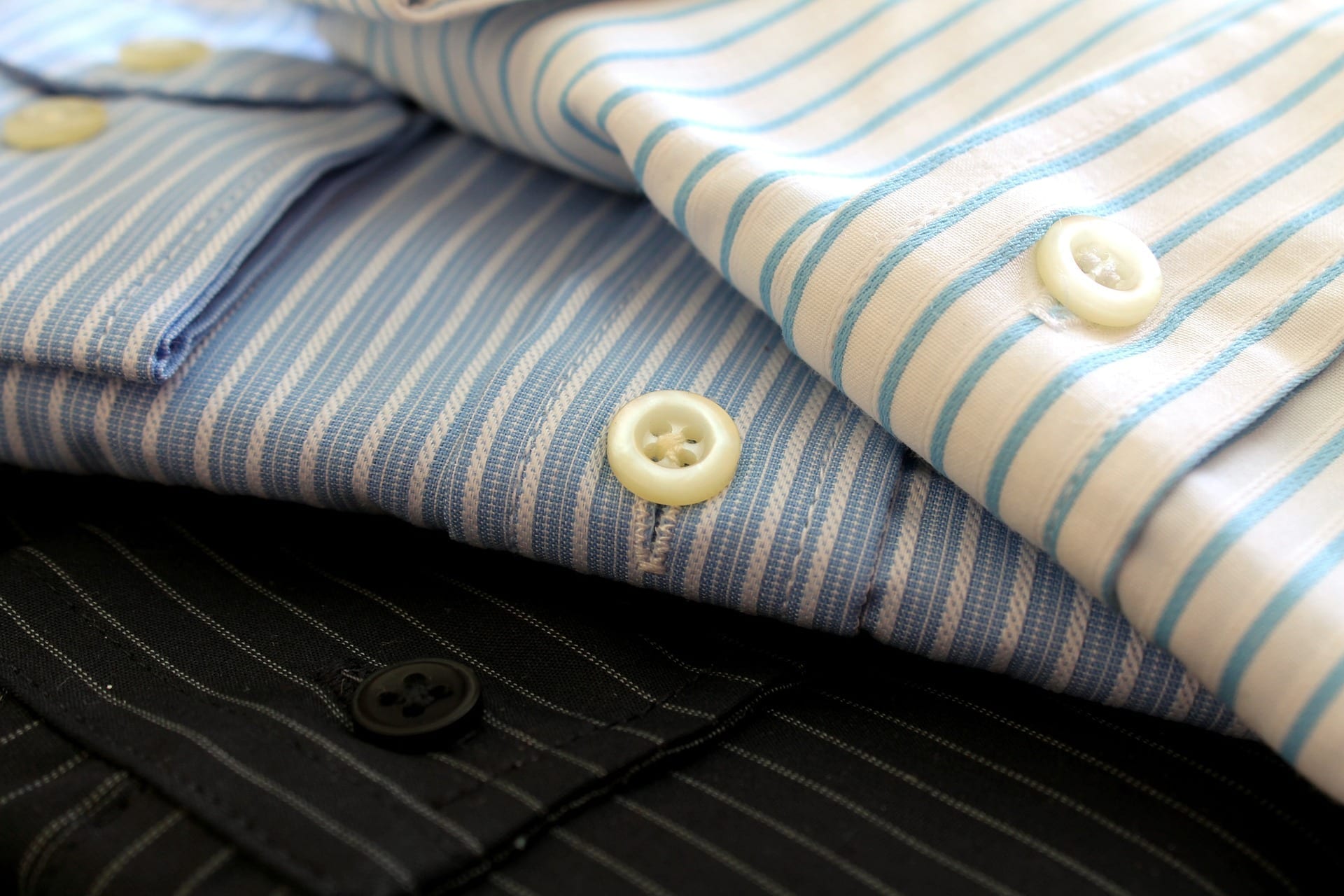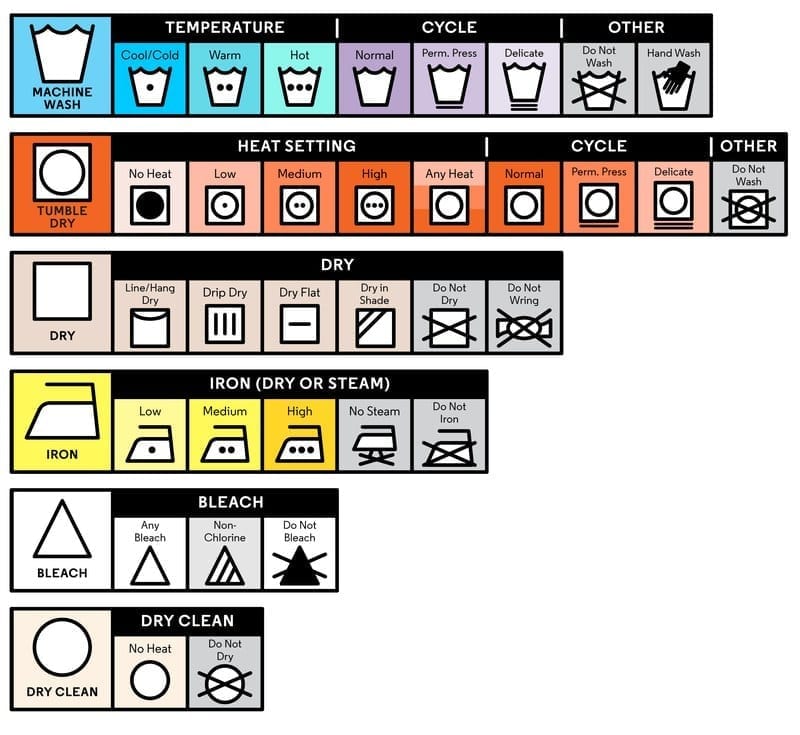
Of all the things you wear and wash in your wardrobe, men’s dress shirts are probably the most frequently laundered.
An ubiquitous staple globally, the dress shirt spans cultures and workplaces – almost every man owns one and most would like to look good while wearing them!
If you’re not careful, it’s easy for the wear and tear of everyday use and laundering to start to show in the state of your shirts. When you’ve invested in good quality, it’s worth your while to pay attention to how your shirt is cared for and have it last the extra distance. You can look better, save money and take a more sustainable approach.
Here are some care tips you should know for looking after your dress shirts:
#1. Read the label
Okay, so this first tip isn’t exactly rocket science, but so many valuable pieces of clothing are ruined because someone didn’t read the label! In saying that, sometimes you need to decode the symbols used to fully understand how to take care of the shirt.
This handy chart from GQ is great for deciphering common symbols on clothing care labels:
 Pay extra attention as to whether or not it’s safe to dry clean the shirt. Many people tend to drop a pile of shirts at the dry cleaners for the convenience of it, but not all shirts will do well with dry cleaning. This depends on the fabric make-up of the shirt – some fabrics will deteriorate with the application of dry cleaning chemicals.
Pay extra attention as to whether or not it’s safe to dry clean the shirt. Many people tend to drop a pile of shirts at the dry cleaners for the convenience of it, but not all shirts will do well with dry cleaning. This depends on the fabric make-up of the shirt – some fabrics will deteriorate with the application of dry cleaning chemicals.
If you go for the “wash and press” method at the dry cleaner’s, be aware that the pressing action in the commercial equipment can be hard on shirts. Collars or buttons often end up smashed, or parts of the shirt can be stretched.
Note also the wash and dry temperature recommendations. These are chosen because fabrics may shrink or be damaged, particularly at higher temperatures. One tip is to separate out your laundry based on fabric colors and the care of the items. You don’t want your white shirts to turn grey or pink, nor do you want to wash with fabrics which might shed lint onto them.
#2. Be wary of the dryer
Dryers can be quite damaging to your clothes. They can shrink items, cause pilling or pulling and lead to very wrinkled dress shirts that have lost their crisp edges.
If the label allows, you can put your shirt in the dryer to start the drying process, but one tip is to use it only long enough to start the drying process, not so long as to allow creases to set in. While of course your shirts should see a steamer or an iron before wear, you’re saving yourself a lot of work if you finish off the drying on a hanger.
Only leave dress shirts in the dryer long enough to start the drying process Share on XOur Eton dress shirts are a great, crease-resistant option for professional wear. The maker’s instructions are very specific, including not putting the shirt in the dryer at all. The following directions come from Eton, and will work well for other, similar dress shirts too:
- Unbutton the shirt
- Place in the washing machine with like colors in a mesh bag to protect buttons and shirt features. Note: do not overfill the washing machine.
- Add fabric softener
- Select warm water and a low spin-dry
- Once the cycle is finished, hang the shirt on a hanger and stretch the collar, cuffs and front placket gently.
The “placket” refers to the double layers of fabric that hold the buttons and buttonholes of the shirt. Mesh clothing bags are inexpensive and usually easy to find from a good tailor, or even on Amazon. They are essential for washing delicate items too.
We would also add that it’s worth investing in good quality, wooden shirt hangers rather than relying on the old wire hanger. Wire hangers can damage clothing and add creasing around the shoulders.
#3. Take care of everyday maintenance
Your shirts will last a lot longer if you take care of them in your day-to-day activities, as well as any maintenance that may be required. For example, if you’re arriving home from work and have no more need to be dressed formally, change out of your shirt. This helps to avoid unnecessary wear and tear – no one needs to be splattering their cooking over their good dress shirts!
Protect your shirt while out eating by opting to use a napkin. It’s much better to catch that drip of sauce on your napkin than having to dab at an unsightly stain! However, if you do manage to get some kind of stain on your shirt, prompt treatment is usually the key. This means treating the stain before putting your shirt into the washing machine – most regular laundry soaps will not work effectively against stains.
Some of the tougher stains you’ll come across include sweat, red wine, coffee, juice and chocolate. Grass and mud stains are also stubborn, although we’d assume most people aren’t rolling around on the ground in their dress shirt…
There are different recommendations for different types of stains, but pretreatment is the key for all of them. It is also suggested that you test a discrete area of your shirt first with the treatment – this is to check that the treatment itself doesn’t cause damage. Marseille Soap (Savon de Marseille) is a great product to have available in your laundry, capable of treating most sorts of stains.
In terms of ongoing maintenance, catching and remedying any issues early is the key. If you’ve got a button hanging off, a simple repair with a basic sewing kit is easier than trying to find a new button!
#4. Store shirts properly
How and where your clothing is stored has a bearing on how well it lasts. The ideal environment is a cool, dark, clean and dry closet. These sorts of conditions help to prevent UV damage or color fading and slow the growth of bacteria.
You don’t have to worry about moths when it comes to your cotton shirts, but any moisture or mildew will do damage to your shirts. Mildew will literally eat cotton fibres and of course, it can leave an unpleasant, musty smell on fabric.
Consider protecting any shirts you won’t be wearing for a while by storing in a garment bag. Think about what you’re doing with them when you’re putting a shirt aside for washing too. Being bunched up in a laundry bag with your damp gym towel is not an ideal way to care for the shirt!
#5. Know how to iron your shirt
While many dress shirts are made from “crease resistant” materials, this doesn’t mean that you can eschew the iron. There’s nothing quite like the look of a freshly pressed shirt to convey a professional appearance.
Cotton and linen shirts require higher iron temperatures in order to reform their shape. It is worth investing in a good quality iron to ensure that you have the required temperature range. Higher-end irons have better quality soleplates for even heat distribution and better steam delivery systems.
Read the label of the shirt for any ironing instructions and iron the shirt in the following order:
- Collar – iron both sides, starting with the bottom side.
- Cuffs – unbutton and lay out flat first. Iron the inside and then the outside.
- Iron the shirt front.
- Iron the back of the shirt.
- Iron the sleeves.
Final thoughts
Your high end dress shirts deserve to be well cared for, and a few simple steps will help to protect your investment and keep them going for longer.
Always read the labels before laundering, and promptly take care of any issues such as stains. As a bonus tip, avoid leaving light-colored shirts sitting in the laundry hamper for too long. This can allow any sweat and oils to set into the fabric and cause premature yellowing. We hope you get a lot of wear from your good dress shirts!




